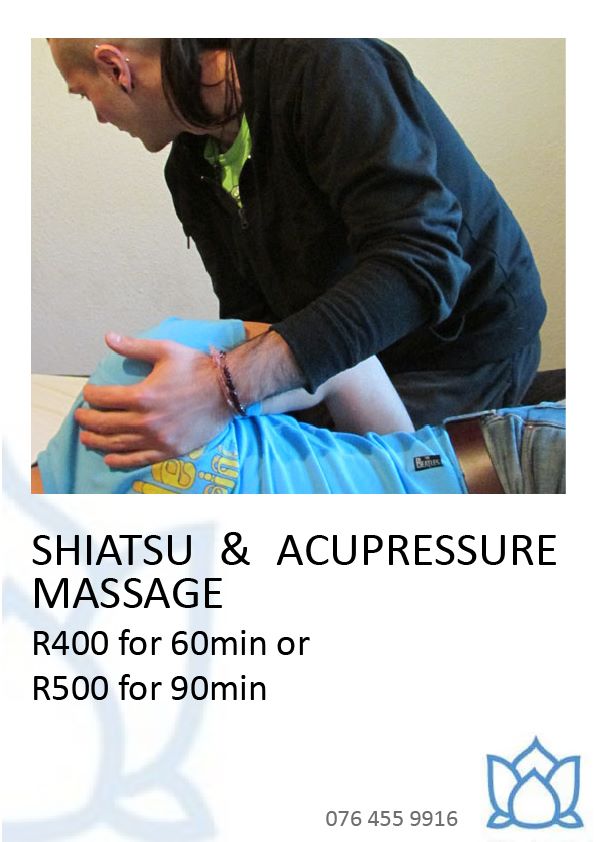Shiatsu Massage


Shiatsu Massage
|
History and Development of Shiatsu Massage / Shiatsu
Treatment Tokujiro Namikoshi Sensei, the Founder of Shiatsu Therapy, was
born November 3rd, 1905 in Kagawa prefecture on Shikoku Island, Japan. When
he was 7 years old, his family moved to Hokkaido where the weather was cold
and harsh. His mother "Masa" developed rheumatoid arthritis as a
result of hard physical labour and the change from a warm to a cold, damp
climate. There was no doctor or medicine available due to the isolation. Tokujiro, only 7 years of age, tried to ease his mother's
pain. He discovered that she felt better when he pressed on her body with his
thumbs, rather than stroking or rubbing. He concentrated his pressure on
points which he found on the cervical region of her spine as well as the
middle and lower back. As he applied himself, he also learned the relationship
between the Adrenal glands and rheumatism. Eventually Masa's rheumatoid
arthritis was cured by Tokujiro's treatment. She
lived in good health to be 88 years of age. From his study and practice he subsequently
developed a scientific anatomical and physiological theory which explained
his treatment. This unique Japanese hands-on therapy, he called
"SHIATSU" (meaning thumb and finger pressure in Japanese). He then
opened his Shiatsu clinic in Sapporo in 1925 and in Tokyo in 1933. In 1953,
he was invited to introduce his Shiatsu at the Palmer Chiropractic School in
Iowa, U.S.A. There he developed a good relationship with Dr.
B.J. Palmer who was a founder of Chiropractic. Toru Namikoshi Sensei, who
is a son of Tokujiro, stayed at the Palmer
Chiropractic School for 7 years to study and compare Shiatsu and
Chiropractic. After he returned to Japan from the U.S., he contributed to the
development of Shiatsu Therapy based on modern Anatomy and Physiology. In 1940, Tokujiro
established his school, the Japan Shiatsu College in Tokyo, and began to
train Shiatsupractors / Shiatsu Practitioners. This
was the first Training school in the world for Shiatsupractors
/ Shiatsu Practitioners. In 1955, the Japan Shiatsu College was officially
licensed by the Ministry of Health in Japan. At present, the 3 year
Registered Shiatsu Therapist program requires students to be in full
attendance for 2500 hours. Upon successful completion of the program the
students are eligible to take a government examination. In 1955, Shiatsu Therapy was first authorized by the
Ministry of Health in Japan. At that time the Ministry mistakenly assumed
that Shiatsu and Western massage were partially Anma,
a type of Acupressure massage from ancient China. In 1964, The Ministry of
Health in Japan realized that Japanese Shiatsu and Western massage didn't
belong to Traditional Chinese Medicine and amended the law so that Anma from China, Shiatsu from Japan and Massage from the
West were all realized as different and unique therapies. Finally, Shiatsu Therapy
obtained legal acknowledgement as a unique therapy. Today, the Ministry of Health in Japan authorizes
Acupuncture, Moxibustion, Anma,
Massage and Shiatsu as "Alternative Therapies" which it regulates
under the license system. This licensing system has promoted a
misunderstanding that Shiatsu belongs to traditional Chinese Medicine. This
is because the Japanese Ministry of Health considers Japanese Shiatsu,
Western Massage and Anma, (all hands on therapies)
to be in one category, As such, they all come under one license. Therapists are required to pass government exams.
Every student in Japan who wants to become a Shiatsu Therapist or a
Registered Massage Therapist must learn the Chinese Meridians to pass the
examination. Students who pass are officially called an "Anma, Massage and Shiatsu Therapist". It is important to recognize that Shiatsu and
Western massage do not belong to Traditional Chinese Medicine. Shiatsu
Therapy was first authorized by the Japanese Ministry of Health in 1955. At
that time, the Ministry considered Anma (a type of
acupressure massage from China), Western Massage and Shiatsu all as one
inclusive therapy. It was not until 1964 that Shiatsu and Western Massage
were recognized by the Ministry of Health in Japan as distinctly different
therapies not belonging to Traditional Chinese Medicine. Although the word "Shiatsu" is originally
Japanese, its meaning has come to be understood in English speaking counties
and throughout the world. |
|||||||||||
|
Definition of Shiatsu "Shiatsu" means shiatsu as originated by
the founder of shiatsu, Tokujiro Namikoshi Sensei. It is the application of manual and
digital pressure to the skin with the aim of preventing and curing illness by
stimulating the body's natural powers of recuperation, eliminating
fatigue-producing elements, and promoting general good health. "Shiatsu technique refers to the use of fingers
and the palm of one's hands to apply pressure to particular sections on the
surface of the body for the purpose of correcting the imbalances of the body,
and for maintaining and promoting health. It is also a method contributing to
the healing of specific illnesses."
|
|||||||||||
Seated, Head, Neck and Shoulder Shiatsu and Acupressure Massage (30min)

Full Body Shiatsu and Acupressure Massage (60min or 90min)


